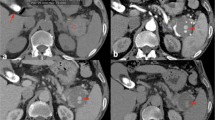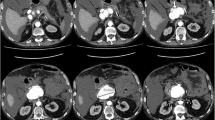Abstract
Visceral artery aneurysms have a potential possibility of rupture with life-threatening hemorrhage, and prompt detection and optimal treatment are required clinically. Actually, abdominal ultrasound plays a major role in detection of visceral artery aneurysms. Besides, the administration of contrast agents can highly improve the characterization of the lesion. Herein, we present two cases of giant peripancreatic artery aneurysm with emphasis on contrast-enhanced ultrasound (CEUS). Case 1 was a 54-year-old asymptomatic man who was diagnosed with a 12.1 cm × 5.2 cm splenic artery aneurysm in the absence of a clear etiologic factor. Case 2 was a 37-year-old man with a 6.3 cm × 5.3 cm pancreaticoduodenal artery pseudoaneurysm associated with chronic pancreatitis. Both diagnoses were confirmed by contrast-enhanced computer tomography (CECT) and digital subtracted angiography (DSA). Transcatheter embolization occlusion using coiling was successfully performed for both cases. Postoperative computed tomography angiography (CTA) showed complete occlusion. It is suggested that CEUS seems to be a promising diagnostic option and contributes to preoperative treatment planning for patients with peripancreatic artery aneurysm.


Similar content being viewed by others
References
Agrawal GA, Johnson PT, Fishman EK. Splenic artery aneurysms and pseudoaneurysms: clinical distinctions and CT appearances. AJR Am J Roentgenol. 2007;188:992–9.
Pescarus R, Montreuil B, Bendavid Y. Giant splenic artery aneurysms: case report and review of the literature. J Vasc Surg. 2005;42:344–7.
Badea R, Chiorean L, Chira O, Caraiani C. Associated gastroduodenal artery aneurysm aortic aneurysm: the diagnostic contribution of contrast-enhanced ultrasound in correlation with computed tomography angiography. J Med Ultrason. 2014;41:217–21.
Tessier DJ, Stone WM, Fowl RJ, et al. Clinical features and management of splenic artery pseudoaneurysm: case series and cumulative review of literature. J Vasc Surg. 2003;38:969–74.
Ballinas-Oseguera GA, Martinez-Ordaz JL, Sinco-Najera TG, et al. Management of pseudoaneurysm of the splenic artery: report of two cases. Cir Cir. 2011;79:268–73.
Kalva SP, Yeddula K, Wicky S, et al. Angiographic intervention in patients with a suspected visceral artery pseudoaneurysm complicating pancreatitis and pancreatic surgery. Arch Surg. 2011;146:647–52.
Ikeda O, Nakasone Y, Tamura Y, et al. Endovascular management of visceral artery pseudoaneurysms: transcatheter coil embolization using the isolation technique. Cardiovasc Interv Radiol. 2010;33:1128–34.
Park JY, Ryu H, Bang S, et al. Hepatic artery pseudoaneurysm associated with plastic biliary stent. Yonsei Med J. 2007;48:546–8.
Helck A, Hoffmann RT, Sommer WH, et al. Diagnosis, therapy monitoring and follow up of renal artery pseudoaneurysm with contrast-enhanced ultrasound in three cases. Clin Hemorheol Microcirc. 2010;46:127–37.
Piscaglia F, Gualandi S, Galassi M, et al. Contrast enhanced ultrasonography for the evaluation of coil embolization of splenic artery aneurysm. Circulation. 2010;122:e451–4.
Ohyama Y, Ishida H, Yoshida C, et al. Pseudoaneurysm in a chronic pancreatitis patient: report of a case, with emphasis on contrast-enhanced sonograms. J Med Ultrason. 2010;37:75–9.
Catalano O, Lobianco R, Cusati B, et al. Contrast-enhanced sonography for diagnosis of ruptured abdominal aortic aneurysm. AJR Am J Roentgenol. 2005;184:423–7.
Clevert DA, Stickel M, Flach P, et al. Contrast-enhanced ultrasound in detection and follow-up of an infrarenal abdominal aortic aneurysm with aorto-caval fistula and endovascular treatment. Cardiovasc Interv Radiol. 2007;30:480–4.
Albrecht T, Blomley M, Bolondi L, et al. Guidelines for the use of contrast agents in ultrasound. Ultraschall Med. 2004;25:249–56.
Conflict of interest
There are no financial or other relations that could lead to a conflict of interest.
Ethical standards
All procedures followed were in accordance with the ethical standards of the responsible committee on human experimentation (institutional and national) and with the Helsinki Declaration of 1975, as revised in 2008 (5). Informed consent was obtained from all patients for being included in the study.
Author information
Authors and Affiliations
Corresponding author
About this article
Cite this article
Liu, B., Zhou, L., Liu, M. et al. Giant peripancreatic artery aneurysm with emphasis on contrast-enhanced ultrasound: report of two cases. J Med Ultrasonics 42, 103–108 (2015). https://doi.org/10.1007/s10396-014-0572-6
Received:
Accepted:
Published:
Issue Date:
DOI: https://doi.org/10.1007/s10396-014-0572-6




